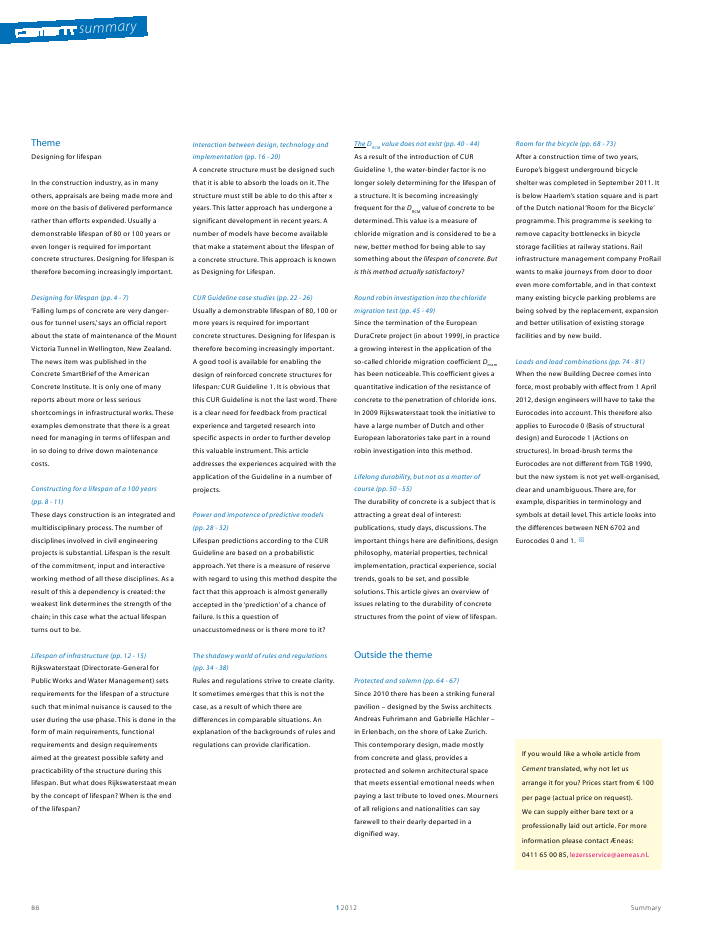Theme: Designing for lifespan

Summary1201286summaryThemeDesigning for lifespanIn the construction industry, as in manyothers, appraisals are being made more andmore on the basis of delivered performancerather than efforts expended. Usually ademonstrable lifespan of 80 or 100 years oreven longer is required for importantconcrete structures. Designing for lifespan istherefore becoming increasingly important.Designing for lifespan (pp. 4 - 7)`Falling lumps of concrete are very danger-ous for tunnel users,'says an official reportabout the state of maintenance of the MountVictoria Tunnel in Wellington, New Zealand.The news item was published in theConcrete SmartBrief of the AmericanConcrete Institute. It is only one of manyreports about more or less seriousshortcomings in infrastructural works. Theseexamples demonstrate that there is a greatneed for managing in terms of lifespan andin so doing to drive down maintenancecosts.Constructing for a lifespan of a 100 years(pp. 8 - 11)These days construction is an integrated andmultidisciplinary process. The number ofdisciplines involved in civil engineeringprojects is substantial. Lifespan is the resultof the commitment, input and interactiveworking method of all these disciplines. As aresult of this a dependency is created: theweakest link determines the strength of thechain; in this case what the actual lifespanturns out to be.Lifespan of infrastructure (pp. 12 - 15)Rijkswaterstaat (Directorate-General forPublic Works and Water Management) setsrequirements for the lifespan of a structuresuch that minimal nuisance is caused to theuser during the use phase. This is done in theform of main requirements, functionalrequirements and design requirementsaimed at the greatest possible safety andpracticability of the structure during thislifespan. But what does Rijkswaterstaat meanby the concept of lifespan? When is the endof the lifespan?Interaction between design, technology andimplementation (pp. 16 - 20)A concrete structure must be designed suchthat it is able to absorb the loads on it. Thestructure must still be able to do this after xyears. This latter approach has undergone asignificant development in recent years. Anumber of models have become availablethat make a statement about the lifespan ofa concrete structure. This approach is knownas Designing for Lifespan.CUR Guideline case studies (pp. 22 - 26)Usually a demonstrable lifespan of 80, 100 ormore years is required for importantconcrete structures. Designing for lifespan istherefore becoming increasingly important.A good tool is available for enabling thedesign of reinforced concrete structures forlifespan: CUR Guideline 1. It is obvious thatthis CUR Guideline is not the last word. Thereis a clear need for feedback from practicalexperience and targeted research intospecific aspects in order to further developthis valuable instrument. This articleaddresses the experiences acquired with theapplication of the Guideline in a number ofprojects.Power and impotence of predictive models(pp. 28 - 32)Lifespan predictions according to the CURGuideline are based on a probabilisticapproach. Yet there is a measure of reservewith regard to using this method despite thefact that this approach is almost generallyaccepted in the`prediction'of a chance offailure. Is this a question ofunaccustomedness or is there more to it?The shadowy world of rules and regulations(pp. 34 - 38)Rules and regulations strive to create clarity.It sometimes emerges that this is not thecase, as a result of which there aredifferences in comparable situations. Anexplanation of the backgrounds of rules andregulations can provide clarification.The DRCMvalue does not exist (pp. 40 - 44)As a result of the introduction of CURGuideline 1, the water-binder factor is nolonger solely determining for the lifespan ofa structure. It is becoming increasinglyfrequent for the DRCMvalueof concrete to bedetermined. This value is a measure ofchloride migration and is considered to be anew, better method for being able to saysomething about the lifespan of concrete. Butis this method actually satisfactory?Round robin investigation into the chloridemigration test (pp. 45 - 49)Since the termination of the EuropeanDuraCrete project (in about 1999), in practicea growing interest in the application of theso-called chloride migration coefficient Dnssmhas been noticeable. This coefficient gives aquantitative indication of the resistance ofconcrete to the penetration of chloride ions.In 2009 Rijkswaterstaat took the initiative tohave a large number of Dutch and otherEuropean laboratories take part in a roundrobin investigation into this method.Lifelong durability, but not as a matter ofcourse (pp. 50 - 55)The durability of concrete is a subject that isattracting a great deal of interest:publications, study days, discussions. Theimportant things here are definitions, designphilosophy, material properties, technicalimplementation, practical experience, socialtrends, goals to be set, and possiblesolutions. This article gives an overview ofissues relating to the durability of concretestructures from the point of view of lifespan.Outside the themeProtected and solemn (pp. 64 - 67)Since 2010 there has been a striking funeralpavilion ? designed by the Swiss architectsAndreas Fuhrimann and Gabrielle H?chler ?in Erlenbach, on the shore of Lake Zurich.This contemporary design, made mostlyfrom concrete and glass, provides aprotected and solemn architectural spacethat meets essential emotional needs whenpaying a last tribute to loved ones. Mournersof all religions and nationalities can sayfarewell to their dearly departed in adignified way.Room for the bicycle (pp. 68 - 73)After a construction time of two years,Europe's biggest underground bicycleshelter was completed in September 2011. Itis below Haarlem's station square and is partof the Dutch national`Room for the Bicycle'programme. This programme is seeking toremove capacity bottlenecks in bicyclestorage facilities at railway stations. Railinfrastructure management company ProRailwants to make journeys from door to dooreven more comfortable, and in that contextmany existing bicycle parking problems arebeing solved by the replacement, expansionand better utilisation of existing storagefacilities and by new build.Loads and load combinations (pp. 74 - 81)When the new Building Decree comes intoforce, most probably with effect from 1 April2012, design engineers will have to take theEurocodes into account. This therefore alsoapplies to Eurocode 0 (Basis of structuraldesign) and Eurocode 1 (Actions onstructures). In broad-brush terms theEurocodes are not different from TGB 1990,but the new system is not yet well-organised,clear and unambiguous. There are, forexample, disparities in terminology andsymbols at detail level. This article looks intothe differences between NEN 6702 andEurocodes 0 and 1. If you would like a whole article fromCement translated, why not let usarrange it for you? Prices start from 100per page (actual price on request).We can supply either bare text or aprofessionally laid out article. For moreinformation please contact ?neas:0411 65 00 85, lezersservice@aeneas.nl.

Reacties